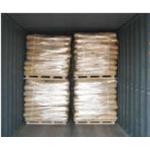Colorless, crystalline solid.
Desmedipham is a carbanilate based herbicide used in the weed control programs in sugar beet.
Selective systemic herbicide used to control broad-leaved weeds such as buckwheat,
chickweed, fiddleneck, kochnia, mustard, pigweed and ragweed.
[3-[[(Phenylamino)carbonyl]oxy]phenyl]carbamic acid ethyl ester is a carbanilate based herbicide used in the weed control programs in sugar beet.
ChEBI: A carbamate ester that is phenylcarbamic acid in which the hydrogen of the hydroxy group has been replaced by a 3-[(ethoxycarbonyl)amino]phenyl group. It is an agrochemical used as a herbicide.
[3-[[(Phenylamino)carbonyl]oxy]phenyl]carbamic acid ethyl ester is a postemergence bis-carbamate herbi- cide used on sugarbeets to control annual weeds such as pigweed, wild mustard, lamb’s quarters, nightshade, chick- weed, buckwheat, goosefoot, ragweed, fiddleneck, and kochia
Soil. Degrades in soil forming the intermediate 3-hydroxycarbanilate (Worthing and
Hance, 1991). The reported half-lives in soil are 70 days, 20 hours and 10 minutes at pH
values of 5, 7 and 9, respectively (Worthing and Hance, 1991).
Plant. In sugar beets, m-aminophenol and ethyl-N-(3-hydroxyphenyl)-carbamate were
identified as metabolites (Hartley and Kidd, 1987).
UN2757 Carbamate pesticides, solid, toxic,
Hazard Class: 6.1; Labels: 6.1-Poisonous materials.
Esters with acids to liberate heat along
with alcohols and acids. Strong oxidizing acids may cause
a vigorous reaction that is sufficiently exothermic to ignite
the reaction products. Heat is also generated by the interac-
tion of esters with caustic solutions. Flammable hydrogen
is generated by mixing esters with alkali metals and
hydrides. Carbamates are incompatible with reducing
agents, strong acids, oxidizing acids, peroxides, and bases.
Contact with active metals or nitrides cause the release of
flammable, and potentially explosive, hydrogen gas. Forms
Carbon monoxide and toxic nitrogen oxides when heated to
decomposition.
Do not discharge into drains
or sewers. Dispose of waste material as hazardous waste
using a licensed disposal contractor to an approved landfill.
Consult with environmental regulatory agencies for guid-
ance on acceptable disposal practices. Incineration with
effluent gas scrubbing is recommended. Containers must be
disposed of properly by following package label directions
or by contacting your local or federal environmental control
agency, or by contacting your regional EPA office.
![[3-[[(Phenylamino)carbonyl]oxy]phenyl]carbamic acid ethyl ester Structure](/CAS/GIF/13684-56-5.gif)


![[3-[[(Phenylamino)carbonyl]oxy]phenyl]carbamic acid ethyl ester pictures](https://img.chemicalbook.com/ProductImageEN/2019-12/Small/38c2d49c-3955-4575-a0ca-1ab0a7203931.jpg)